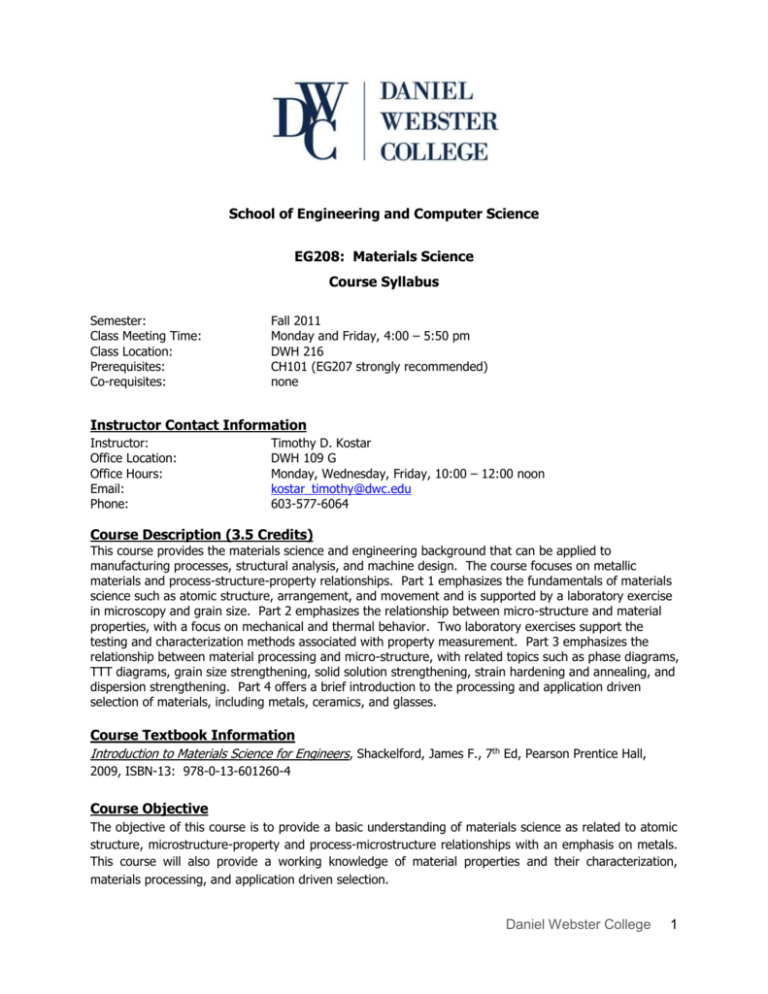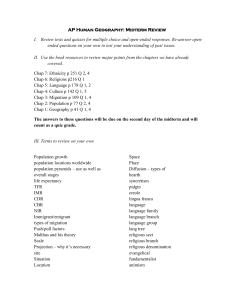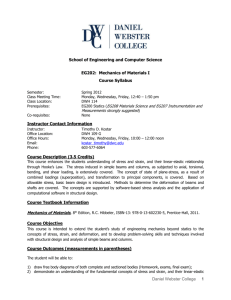
School of Engineering and Computer Science
EG208: Materials Science
Course Syllabus
Semester:
Class Meeting Time:
Class Location:
Prerequisites:
Co-requisites:
Fall 2011
Monday and Friday, 4:00 – 5:50 pm
DWH 216
CH101 (EG207 strongly recommended)
none
Instructor Contact Information
Instructor:
Office Location:
Office Hours:
Email:
Phone:
Timothy D. Kostar
DWH 109 G
Monday, Wednesday, Friday, 10:00 – 12:00 noon
kostar_timothy@dwc.edu
603-577-6064
Course Description (3.5 Credits)
This course provides the materials science and engineering background that can be applied to
manufacturing processes, structural analysis, and machine design. The course focuses on metallic
materials and process-structure-property relationships. Part 1 emphasizes the fundamentals of materials
science such as atomic structure, arrangement, and movement and is supported by a laboratory exercise
in microscopy and grain size. Part 2 emphasizes the relationship between micro-structure and material
properties, with a focus on mechanical and thermal behavior. Two laboratory exercises support the
testing and characterization methods associated with property measurement. Part 3 emphasizes the
relationship between material processing and micro-structure, with related topics such as phase diagrams,
TTT diagrams, grain size strengthening, solid solution strengthening, strain hardening and annealing, and
dispersion strengthening. Part 4 offers a brief introduction to the processing and application driven
selection of materials, including metals, ceramics, and glasses.
Course Textbook Information
Introduction to Materials Science for Engineers, Shackelford, James F., 7th Ed, Pearson Prentice Hall,
2009, ISBN-13: 978-0-13-601260-4
Course Objective
The objective of this course is to provide a basic understanding of materials science as related to atomic
structure, microstructure-property and process-microstructure relationships with an emphasis on metals.
This course will also provide a working knowledge of material properties and their characterization,
materials processing, and application driven selection.
Daniel Webster College
1
Course Outcomes (measurements in parentheses)
1) The student will demonstrate knowledge of the basic physics involved in determining atomic structure,
and the primary bond types (Chap. 2 HW, Mid-Term Exam).
2) The student will demonstrate knowledge of atomic structure of materials (metals, polymers, ceramics),
its quantitative description, and the X-Ray diffraction characterization method (Chap. 3 HW, Mid-Term
Exam).
3) The student will be able to explain the causes, types, and effects of crystalline defects, grain formation
and its characterization (Chap. 4 HW, Mid-Term Exam, Lab #1).
4) The student will demonstrate knowledge of the basic diffusion process and how it relates to atomic
motion (Chap. 5 HW, Mid-Term Exam).
5) The student will demonstrate knowledge of, and be able to characterize, the mechanical behavior of
materials (Chap. 6 HW, Final Exam, Lab #2, Lab #3).
6) The student will demonstrate knowledge of the basic physics involved in determining the thermal
behavior of materials (Chap. 7 HW, Final Exam).
7) The student will demonstrate the ability to analyze basic failure mechanisms (Chap. 8 HW, Final
Exam).
8) The student will apply Phase Diagrams to predict microstructural development under specified processing
conditions (Chap. 9 HW, Final Exam).
9) The student will understand the kinetics of heat treatment processes, utilization of a TTT Diagram, and
various hardening methods and mechanisms (Chap. 10 HW, Final Exam).
10) The students will be able to select a suitable material (metal, ceramic, glass) for a given application
based on an understanding of their processing, properties, and performance (Chap. 11 HW, Final
Exam).
General Education Competencies
The General Education program centers on critical thinking, communication, and global citizenship. The
primary General Education competencies that this course supports include:
-
Communicate clearly and effectively in written, oral, and electronic forms
Apply quantitative reasoning skills to solve problems
Disabled Applicants and Students
Daniel Webster College is committed to compliance with Section 504 of the Rehabilitation Act of 1973 and
its regulations. The school does not discriminate on the basis of disability in admission or access to, or
treatment or employment in, its programs and activities. The school's student disability coordinator
coordinates Section 504 compliance. Applicants or students with a disability may request an
accommodation by contacting Kathy Hipp, Associate Dean of Arts and Sciences, at 603-577-6659 or
hipp@dwc.edu.
Academic Honesty
Intellectual curiosity is at the heart of the academic enterprise. Students, faculty and administration at
Daniel Webster College consider such violations as cheating and plagiarism to be so unethical as to call
into question whether the violator should continue as a member of the College community. Transcripts
that misrepresent academic performance not only endanger students’ chances for success in their careers
but also damage the integrity and reputation of the institution.
Student Honor Pledge
Daniel Webster College believes that all students have the right to learn in an academic community that
insures fair competition, and respects truth and honesty. Academic dishonesty is not tolerated at Daniel
Webster College. The Student Honor Pledge is intended to create a community of fairness, respect, and
responsibility in the pursuit of academic enterprise. All students are expected to abide by the Student
Honor Pledge.
I pledge on my honor, as a student at Daniel Webster College, that I have neither given nor
received any unauthorized aid on this assignment/examination.
Daniel Webster College
2
For more information regarding Daniel Webster College’s ethical standards, please refer to the current
college catalog.
Grading Scale
The following scale is based on the grading structure outlined in the Daniel Webster College catalog and
is used to assign letter grades:
A = 93+
C+= 76-79
A- = 90-92
C = 70-75
B+= 87-89
D = 65-69
B = 83-86
F = Below 65
B- = 80-82
Expectations
Homework problems from the text, and potentially other sources, will be assigned on a regular basis and
are subject to change. It is expected that the interested student will endeavor to solve these problems.
Remember that you cannot adequately learn this material without practicing the methods.
Talk to me in advance if you have reasonable reason(s) for not being able to turn in your homework or
any assignment on time. To be fair to all students, late homework or other assignments are given a 33%
reduction in points per day that the homework / assignment is late. A “day” is defined as 24 hours,
beginning at the start of class time.
In addition, there will be three (3) laboratory assignments which you will work on in small groups
outside of class time, and will require detailed reports. Finally, in support of the student evaluation
process, there will be one (1) midterm exam, and one (1) comprehensive final exam. No makeups for exams will be given unless satisfactory advanced notice and reason is supplied to the
instructor. The grades will not be curved. The grades will be assigned based on the absolute grade scale
shown above.
Active class participation is expected. In this course you will be expected to act in a professional
manner. Among other things, this includes showing up on time prepared for the task at hand. This shall
include not just being on time for class, but also for any and all additional outside meetings you will have
with group work. You will be expected to read assigned chapters/tutorials before coming to class and be
ready to actively participate. Classroom activities such as chatting, use of computer, ipod, cell phone and
other electronics are not allowed.
Students may ask questions of one another when working on out-of-class assignments. However, each
student/team must do their own work. A first occurrence of academic dishonesty will result in a
zero for that assignment for all who are involved. A second occurrence will result in an F for the course.
Note that all such occurrences must be reported in writing to the Chief Academic Officer who may
prescribe additional penalties.
Course Evaluation
Homework
21%
Lab #1
8%
Lab #2
8%
Lab #3
8%
Midterm Exam
25%
Final Exam
30%
________________________________________
Total
100%
Daniel Webster College
3
Planned Schedule of Activities
Schedule may be modified, with announcements posted on-line.
Week
1
Reading
Topics
Assignments
08/30
09/02
Only
Friday
class
09/05
09/09
Chap. 1
Course Overview: Syllabus walk-thru, administrative policies, course
expectations. Materials for Engineering: Why materials are important,
the basic material types, examples of materials, the concept of processmicrostructure-properties.
Chap. 2
Atomic Bonding: Atomic structure, Ionic, covalent, and metallic bonds,
the secondary van der Waals Bond.
3
09/12
09/16
Chap. 3.1 – 3.5
4
09/19
09/23
5
2
6
7
8
Crystalline Structure (Perfect): 7 systems and 14 lattices. Metal,
ceramic, and polymeric structures.
2.5, 2.6, 2.10, 2.13, 2.15,
2.25, 2.32, 2.34, 2.42, 2.48,
2.51
3.3, 3.4, 3.9, 3.11, 3.12,
3.16, 3.22, 3.23
Chap. 3.6-3.7
Crystalline Structure (Perfect): Lattice positions, directions, and planes,
X-ray diffraction
Lab #1
3.25, 3.31, 3.33, 3.41, 3.58,
3.67, 3.70, 3.82
09/26
09/30
Chap. 4.
Crystalline Defects and noncrystalline structure (Imperfection):
Chemical imperfections (solid solution), Point defects, Line defects (1D
dislocations), Planar defects (2D), Noncrystalline solids (3D imperfections).
4.1, 4.14, 4.17, 4.194.21,
4.25, 4.27, 4.28
10/03
10/07
Chap. 5
10/11
10/14
Monday
class on
Tuesday
10/17
10/21
Review and
Mid-Term
Exam
Diffusion: Thermally activated processes, Thermal production of point
defects, point defects and solid state diffusion, steady-state diffusion.
5.1, 5.3, 5.5, 5.9, 5.10, 5.12
5.25, 5.27, 5.29
Review
Covers Chapters 1, 2, 3, 4, 5
Chap. 6
Mechanical Behavior: Stress vs. Strain (metals, ceramics, polymers),
Elastic deformation, plastic deformation, Hardness, Creep and Stress
Relaxation.
6.2, 6.4, 6.9, 6.19, 6.23
6.27, 6.29, 6.41, 6.43
6.49, 6.52
Lab #2
9
10/24
10/28
Chap. 7
Thermal Behavior: Heat capacity, thermal expansion, thermal
conductivity, thermal shock.
10
10/31
11/04
Chap. 8
Failure Analysis and Prevention: Impact energy, Fracture toughness,
Fatigue, Non-destructive testing, Failure analysis.
8.4, 8.8, 8.14, 8.19, 8.21
8.26, 8.34, 8.35
11
11/07
11/11
Chap. 9
Phase Diagrams- Equilibrium Microstructure Development: The Phase
Rule, The Phase Diagram, The Lever Rule, Micro-structural development
during slow cooling.
9.2, 9.4, 9.7, 9.13, 9.17
9.25, 9.33, 9.36, 9.45, 9.61
12
11/14
11/18
11/21
11/25
No
Friday
class
11/28
12/02
Chap. 10
Kinetics-Heat Treatment: Time and the TTT Diagram, Harden-ability,
Precipitation hardening, Annealing, Cold Working.
Review
Chap. 11
15
12/05
12/09
Chap. 12
Structural Materials- Metals, Ceramics, and Glasses: Metals (ferrous,
non-ferrous), Ceramics and Glasses (crystalline and non-crystalline),
Processing the structural materials (processing of metals, ceramics, and
glasses)
Structural Materials- Polymers and Composites: Polymerization,
thermo-sets, thermo-plastics, Composites (FRP), Processing of Polymers,
Processing of Composites. (*) Time Permitting
Final
Exam
12/12
12/16
13
14
7.1, 7.3, 7.4, 7.5, 7.7, 7.9,
7.12, 7.13, 7.16, 7.19
Lab #3
10.1, 10.7, 10.9, 10.11
10.23, 10.39, 10.40
11.1, 11.5, 11.8, 11.9, 11.17
11.27, 11.31, 11.37
12.2, 12.14, 12.21, 12.35
12.46, 12.65, 12.67
Comprehensive, with emphasis on Chaps. 6, 7, 8, 9, 10, 11
Daniel Webster College
4
Relationship of Course to Program Outcomes
Mechanical Engineering
(slight, moderate, substantial)
Outcome
Level of
contribution
Outcome
Level of
contribution
Outcome
a
b
c
d
e
f
g
h
i
j
k
l
m
a
b
substantial
moderate
h
i
slight
c
d
e
f
substantial
j
g
slight
k
l
m
moderate
moderate
slight
Description of Outcome
an ability to apply knowledge of mathematics, science, and engineering
an ability to design and conduct experiments, as well as to analyze and interpret data
an ability to design a system, component, or process to meet desired needs within realistic
constraints …
an ability to function on multi-disciplinary teams
an ability to identify, formulate, and solve engineering problems
an understanding of professional and ethical responsibility
an ability to communicate effectively
the broad education necessary to understand the impact of engineering solutions in a
global, etc., societal context
a recognition of the need for, and the ability to engage in life-long learning
a knowledge of contemporary issues
an ability to use the techniques, skills, and modern engineering tools needed for
engineering practice
an ability to apply principles of engineering, basic science, and mathematics (including
multivariate calculus and differential equations) to model, analyze, design, and realize
physical systems, components or processes.
an ability to work professionally in both thermal and mechanical systems areas.
Daniel Webster College
5
Relationship of Course to Program Outcomes
Aeronautical Engineering
(slight, moderate, substantial)
Outcome
Level of
contribution
Outcome
Level of
contribution
Outcome
a
b
c
d
e
f
g
h
i
j
k
l
m
n
a
b
substantial
moderate
h
i
slight
c
d
e
f
substantial
j
k
l
g
slight
m
n
moderate
Description of Outcome
an ability to apply knowledge of mathematics, science, and engineering
an ability to design and conduct experiments, as well as to analyze and interpret data
an ability to design a system, component, or process to meet desired needs within realistic
constraints …
an ability to function on multi-disciplinary teams
an ability to identify, formulate, and solve engineering problems
an understanding of professional and ethical responsibility
an ability to communicate effectively
the broad education necessary to understand the impact of engineering solutions in a
global, etc., societal context
a recognition of the need for, and the ability to engage in life-long learning
a knowledge of contemporary issues
an ability to use the techniques, skills, and modern engineering tools needed for
engineering practice
a knowledge of aerodynamics, aerospace materials, structures, propulsion, flight
mechanics, and stability and control
design competence that includes integration of aeronautical topics
an ability to develop flight test plans and conduct in-flight experiments, as well as to
analyze, etc., the resulting data
Daniel Webster College
6
Materials Science Laboratory Assessment Rubric
The primary learning outcomes of a laboratory exercise include:
-
-
Demonstrate a general understanding of the topic including background, motivation for doing the
lab, the relevance of the laboratory, specific objectives.
Develop and demonstrate the ability to conduct experiments, gather and reduce data, create
appropriate tables and graphs.
Develop and demonstrate the ability to draw conclusions from results, identify root causes or
relationships between expected and actual data, and show technical insight to the physical
phenomena.
Demonstrate advanced technical writing skills (lab report), including completeness and clarity of
presentation, grammar.
Reference:
This laboratory exercise and the associated report are conducted by a small team of students (typically 35 students). There are three (3) laboratory exercises in this course.
Assessment:
Laboratory ID:____________________
Performance
Indicator
Criteria
Evaluation
Beginning (1)
Developing (2)
Accomplished (3)
Exemplary (4)
General
Knowledge of
Topic
Little to no
understanding of
topic details.
Showed some
understanding of
topic details.
Demonstrated an
understanding of the
topic details.
Demonstrated
understanding of
topic and related
topic details.
Data Gathering
and Reduction
Did not show
ability to gather,
reduce, and
display data.
Showed some
ability to gather,
reduce, and display
data.
Demonstrated ability to
gather, reduce, and
display data.
Demonstrated ability
to gather, reduce,
and display data with
attention to detail.
Analytical
Thinking
Did not show
ability to draw
conclusions from
results, and
identify root
causes and
physical
relationships.
Showed some
ability to draw
conclusions from
results, and identify
root causes and
physical
relationships.
Demonstrated ability to
draw conclusions from
results, and identify
root causes and
physical relationships.
Demonstrated ability
to draw conclusions
from results, and
identify root causes
and physical
relationships, and
show additional
technical insight.
Technical
Writing
Did not
demonstrate
advanced
technical writing
skills.
Demonstrated
some technical
writing skills.
Demonstrated ability to
write a clear and
comprehensive lab
report.
Demonstrated ability
to write a clear and
comprehensive lab
report, including
grammatical details.
Total
Daniel Webster College
7






